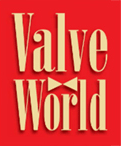Residue hydrocracking technologies are evolving, but persistent challenges like fouling and sulphidation continue to impact valve performance. Through field insights and experimental research, Velan has developed coatings that considerably reduce fouling and extend the life of valves in these harsh environments. This innovation aims to improve corrosion, coking performance and reliability in residue upgrading, offering a new solution for the industry.
By Fadila Khelfaoui and Luc Vernhes, Velan Inc.
Residue hydrocracking technology has been evolving since the early 20th century to maximise the conversion of heavy crude residues into valuable products.
Over the decades, advancements have led to the development of more efficient processes with higher conversion rates and improved economic feasibility. Since the 1980s, Velan has played a key role in this evolution, supplying ball valves for the delayed coker market, one of the most widely used processes for breaking down heavy oil at low pressure and high temperature.
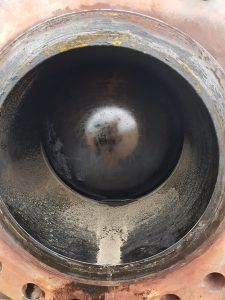
The delayed coker process, first introduced in 1929, remains a dominant residue conversion method, with over 200 operating units worldwide. This thermal cracking process achieves conversion rates of up to 80%, transforming heavy residues into lighter hydrocarbons. Additionally, it has evolved to produce valuable by-products such as needle coke, essential for battery and electrode manufacturing. However, as refiners sought even higher yields and reduced coke formation, new hydrocracking technologies emerged to improve conversion rates.
The 1960s saw the development of ebullated bed hydrocracking, which introduced a more advanced approach to residue processing. Unlike delayed coking, this process utilises a catalyst in a fluidised bed, improving hydrogenation and reducing coke formation.
Technologies such as H-Oil® (Axens) and LC-FINING / LC-MAX (CLG) became industry standards. This process significantly boosted conversion rates to 70-90%, with around 30 operating units globally. Despite these advantages, ebullated bed hydrocracking required higher capital investment and operational complexity, leading to the search for even more advanced solutions.
By the 1980s, slurry-phase hydrocracking emerged as one of the most advanced residue upgrading technology. This process delivers conversion rates of 90-99%, virtually eliminating coke while maximising liquid yields. However, due to its higher operational complexity, it has been adopted in only around 10 units worldwide.
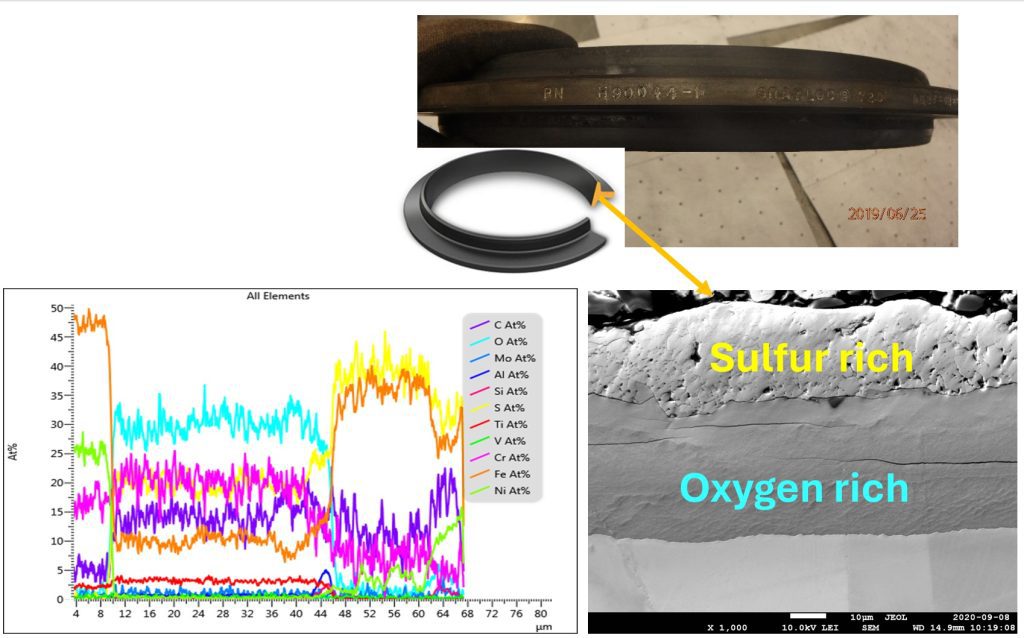
Persistent challenges: fouling and coke deposition
As residue upgrading technologies continue to evolve, one persistent challenge across all processes is fouling and coke deposition in stagnant areas (see Figure 1). This buildup can damage sealing surfaces, increase torque requirements, and reduce operational efficiency. One common mitigation strategy is purging valves with clean fluid, but this approach comes with its own complexities, including additional maintenance and unexpected outages. The tendency of materials to accumulate coke varies, making material selection a critical factor in enhancing long-term performance. Through ongoing discussions with industry experts and close collaboration with end-users, Velan is involved in the development of advanced surface treatments designed to minimise fouling, ensuring more reliable and efficient operation across various residue upgrading processes.
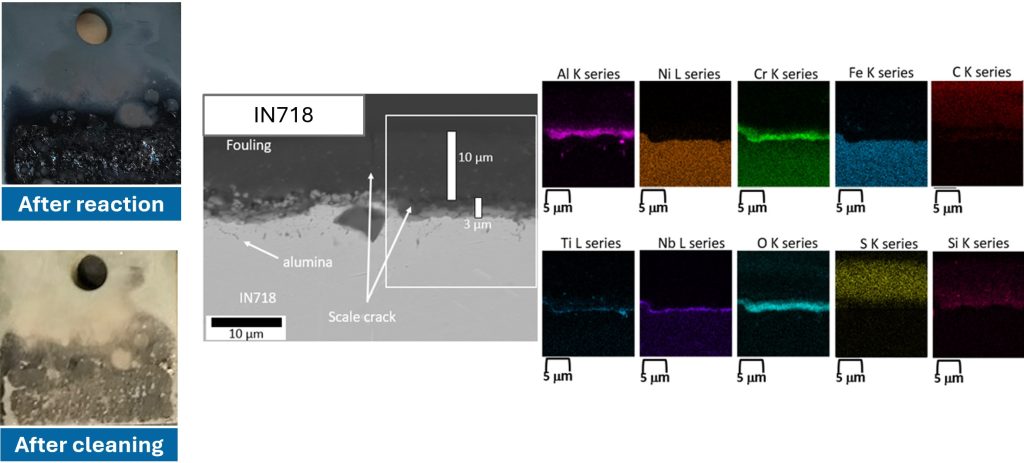
Understanding the challenges: from field insights to innovation
The mechanisms behind fouling and coke buildup remain poorly understood. To gain deeper insights, field visits to resid upgraders were conducted to gather firsthand information on recurring valve performance issues and acquire failed components for metallurgical analysis. Microstructural evaluations of these components revealed scale buildup, characterised by distinct sulphidation and oxidation patterns, accompanied by preferential depletion of alloying elements (see Figure 2). The thickness of this buildup varied based on service duration and component location, with different alloys exhibiting similar degradation patterns. These findings, coupled with discussions with end-users, catalysed R&D efforts to replicate the hydrocracking environment in a laboratory setting.

While small- scale reactors cannot fully mimic refinery environments, they provide critical insights into corrosion and fouling mechanisms in a controlled setting. Custom experimental reactors were developed to operate at refinery temperatures and pressures. Samples were exposed to bitumen sourced from both a licensor and an Alberta refinery at 450°C (842°F) and 114 bar (1650 psi); in addition, testing was performed with hydrogen and catalyst and without catalyst.
Nickel-based alloys, commonly used in these harsh environments, offer excellent high-temperature strength and corrosion resistance. However, detailed post-exposure analysis revealed distinct three-layer degradation: an oxygen-rich layer adjacent to the substrate, a sulphur-rich layer above the oxide, and a carbon-dominant outermost layer (see Figure 3). These layers closely mirrored those observed in field samples, validating the failure mechanisms encountered in service.
A fundamental understanding emerged: the interplay between alloy composition, microstructure, and surface energy significantly influences fouling mechanisms. Finding alloy substrates that are completely immune to fouling in refining and petrochemical applications remains a challenge.
Role of coatings in fouling mitigation
The solution to fouling and sulphidation corrosion in hydrocracking processes appears to be coatings. Desired coating properties include engineered microstructures that maintain wear and corrosion resistance in these aggressive environments. The coated substrates under simulated resid upgrading conditions exhibited significantly improved resistance to fouling and sulphidation corrosion compared to uncoated materials. However, standard thermally sprayed and fused cobalt-based coating (Co-1) did not prevent sulphidation and coke buildup, indicating the need for further optimisation.
A comparative study of standard (Co-1) and optimised (Co-3) cobalt-based coatings using optical imaging processing method demonstrated a significant reduction in fouling intensity, from 96% to just 3% with the optimised coating (see Figure 4). Further destructive testing confirmed that sulphur and coke buildup were significantly higher in Co-1 coating, highlighting the critical interplay between sulphidation and fouling mechanisms (see Figure 5). This synergy accelerates material degradation but also reinforces the superior performance of Co-3 coating in resid upgrading environments.
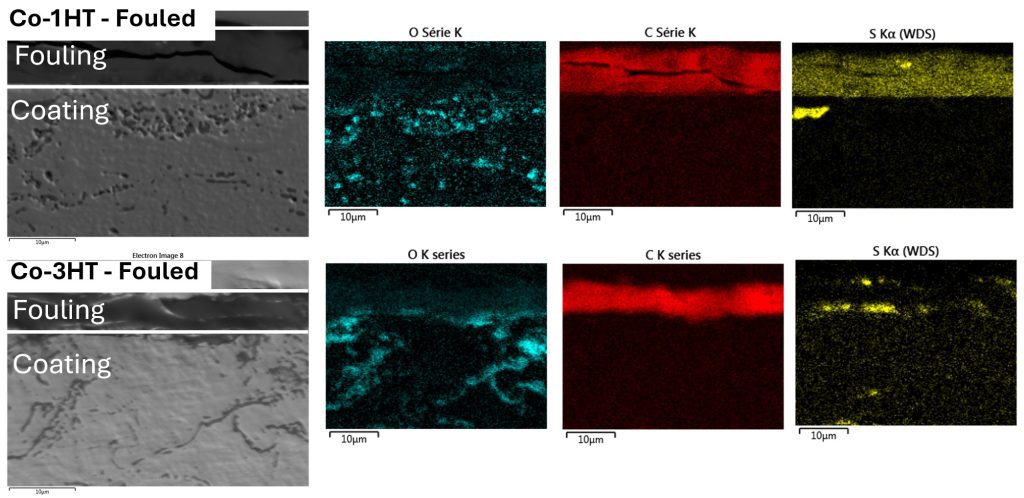
Predicting fouling and corrosion in resid upgrading processes
Based on our experimental testing data, a phenomenological model was developed to describe different fouling modes in three distinct scenarios (see Figure 6):
- Fouling with temperature, catalyst, and hydrogen: similar to a slurry cracker, where the catalyst is present in the line.
- Fouling with temperature and hydrogen only: similar to an ebullated bed, where most of the catalyst remains inside the reactors.
- Fouling with temperature only: similar to a coker, where neither hydrogen nor catalyst is present.
Our findings suggest that fouling mechanisms are influenced by the interaction of temperature, catalyst and hydrogen. In the first scenario, sulphidation attacks grain boundaries, leaching alloying elements such as iron, nickel, titanium and aluminium. The corrosion products act also as catalysts, increasing the decomposition rate if hydrocarbons locally which increase the sulphur and sulphidation rate.
This intergranular corrosion roughens the surface, making it more prone to coke adhesion. However, due to higher conversion rate, the amount of adherent coke is less than in the second and third scenarios. In the second scenario the sulphidation is more uniform. Although there is slight tendency toward the grain boundaries, leaching of alloying elements is less pronounced. While the amount of coke buildup is greater than in first scenario, coke adhesion on the sulphide layer is less. The sulphide-rich scale is thicker than in first scenario and tends to delaminate.
The third scenario sees the highest coke buildup due to the lowest conversion rate, but with a more stable oxide layer providing some protection.
The model confirms that while hydrogen and catalyst increase conversion rates, they also accelerate corrosion, necessitating advanced coatings for valve protection in high-conversion processes.
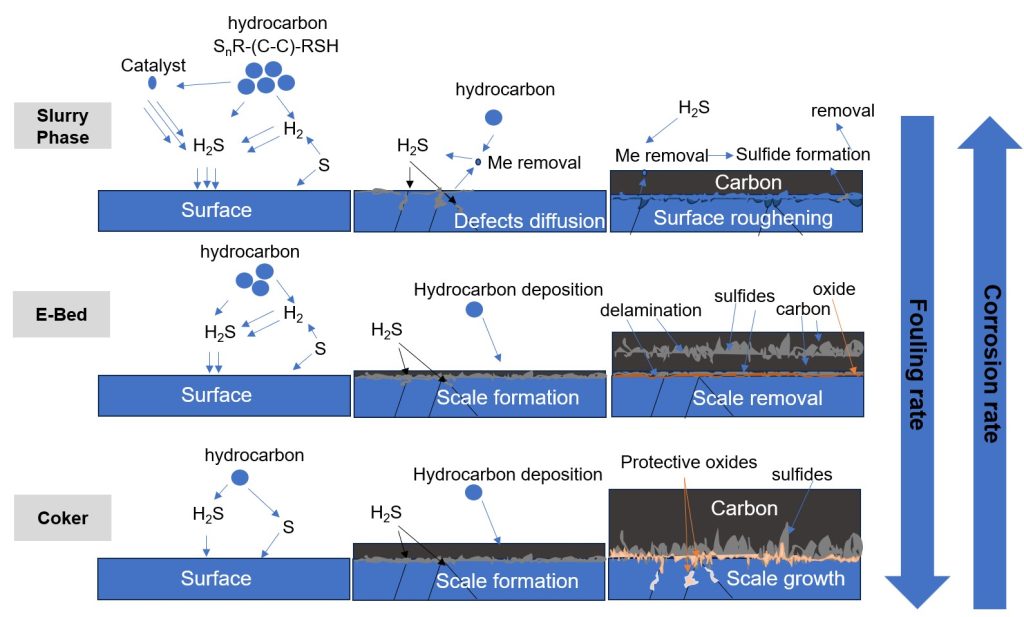
Disruptive technology: a breakthrough in coating performance
By better understanding the fundamental mechanisms leading to fouling including the synergy between sulphidation and coke adhesion, we have designed coating structures that virtually eliminates sulphidation, hence preventing fouling. One prime example is a proprietary coating tested under resid upgrading conditions that does not react with sulphur. As confirmed by EDS mapping, sulphur was absent on the coated sample. Concurrently, no coke adhesion was detected (see Figure 7). By blocking one failure mechanism, the other was effectively controlled.
Towards a new standard in coating performance
This research underscores the critical role of advanced coatings in mitigating fouling and extending component life in resid upgrading environments. While specific coating compositions remain proprietary, the methodologies and testing approaches developed in this study represent a significant step forward in enhancing valve and component performance. By combining innovative coating formulations with rigorous experimental validation, the industry can move toward more reliable and efficient heavy oil processing solutions. The continued development of high-performance coatings tailored for fouling and coking environments will play a pivotal role in improving refinery operations and reducing maintenance costs, ensuring that critical infrastructure remains resilient in the face of evolving industry challenges. All tests conducted so far have been in a laboratory environment. Velan is currently in discussions with licensors and end-users to scale-up the coating technology and conduct field tests.
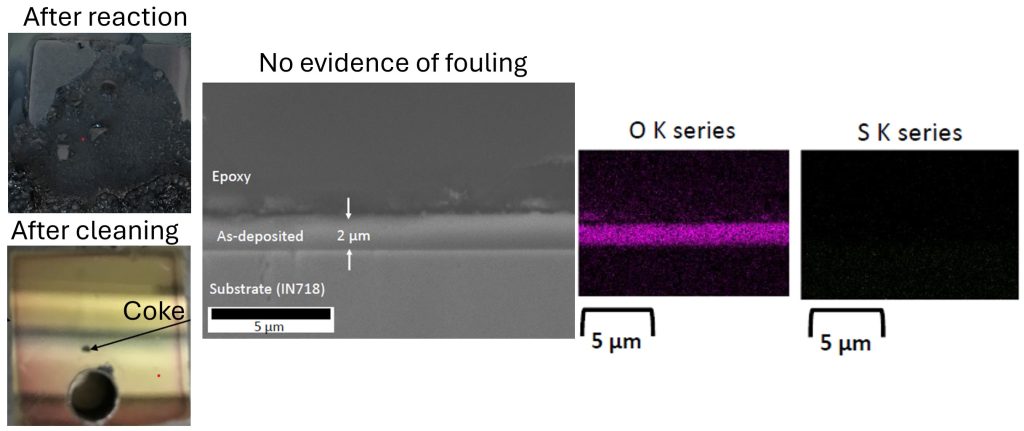
Acknowledgments
We would like to thank the team of researchers from the University of Montreal for their dedication to this project, particularly Dr. Fellipy Rocha, who transitioned from student to PhD graduate during this research. We also acknowledge the Multisectorial Industrial Research Chair in Coatings and Surface Engineering (MIC-CSE), which Velan has funded since 2012 alongside other industrial partners. Based at Polytechnique Montreal on the University of Montreal campus, MIC-CSE stands as the second-largest industrial research chair in Canada. Our thanks go to all contributors for their teamwork and invaluable efforts in advancing our understanding of the fundamental mechanisms governing our products, ultimately enhancing their reliability and performance. Lastly, we appreciate the financial support from the Canadian and Quebec governments, which has been instrumental in making this research possible.
About the Authors
 Fadila Khelfaoui is a Corporate Engineer at Velan with 27 years of experience in metallurgy and materials engineering, specialising in coatings and surface engineering. She has led high-profile projects that bridge R&D and engineering, driving innovative material solutions from concept to field application in demanding industrial environments. Fadila is a licensed Metallurgical Engineer in Quebec and holds a PhD in Material Science & Engineering.
Fadila Khelfaoui is a Corporate Engineer at Velan with 27 years of experience in metallurgy and materials engineering, specialising in coatings and surface engineering. She has led high-profile projects that bridge R&D and engineering, driving innovative material solutions from concept to field application in demanding industrial environments. Fadila is a licensed Metallurgical Engineer in Quebec and holds a PhD in Material Science & Engineering.
 Luc Vernhes joined Velan in 2003 and has held multiple positions over the years. He is now Director, Business Development. He holds a PhD in Engineering Physics and is a Mechanical Engineer.
Luc Vernhes joined Velan in 2003 and has held multiple positions over the years. He is now Director, Business Development. He holds a PhD in Engineering Physics and is a Mechanical Engineer.
About this Technical Story
This Technical Story is an article from our Valve World Magazine, March 2025 issue. To read other featured stories and many more articles, subscribe to our print magazine. Available in both print and digital formats. DIGITAL MAGAZINE SUBSCRIPTIONS ARE NOW FREE.
“Every week we share a new Technical Story with our Valve World community. Join us and let’s share your Featured Story on Valve World online and in print.”
